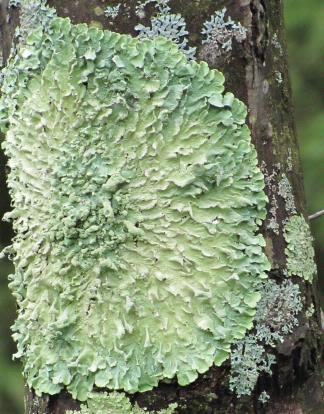Lichenology
Last week in this space I wrote about humans as an invasive species. This week I wish to propose another possibility. This was suggested by a very slow walk up Bare Mt while monitoring our shortest indigent boarder. When a walk that short takes a few hours, you have some time to look around. What caught my eye was the lichen.
Lichens are more of an association than a single organism. The part that one might recognize on rocks or trees is the fungal part of this association — the mycobiont. The other part is either a green algae or a cyanobacterium: the photobiont.
One lichenologist, Trevor Goward, calls lichen “fungi that have discovered agriculture.” I like this formulation. A symbiotic relationship is one in which both partners get something significant out of the deal, a parasitic relationship is where only one gets the benefit. Lichens don’t really fit into either. The photobiont photosynthesizes and so provides energy to the fungus. The fungus picks up some nutrients and water from the air, but really provides little for the photobiont. It does, however, extend the range of climates that the algae can live in.
Lichens can live anywhere and can survive complete desiccation. In 2005 scientists from the European space agency sent some lichen into space along with a trip to the space station. Two species were exposed to open space for a little over two weeks: harsh UV rays, widely varying temperatures, no atmosphere, and of course aliens. When brought back to earth, both species (four organisms) continued to grow undaunted.
Yet lichens are nowhere near invasive. They live for many thousands of years. This means colonies can be used to measure the amount of time that a rock surface has been exposed (based on the size of the colony). They don’t grow very quickly: often less than a centimeter a year. Some of the Antarctic lichens only grow a centimeter every thousand years. That’s less progress than congress!
I’d like to adopt a more lichen like relationship with what feeds us rather than the invasive habit. The lichen protects the photobiont and to some extent nurtures it. This allows the fungus to grow places it couldn’t otherwise survive. That’s what agriculture does for us, we just need to grow a bit more slowly. I like to think that gardening encourages me to remember my dependence on other species, this then can lead me to a little more respect.
Last week in this space I portrayed humans as an invasive species. This week I wish to propose another possibility. This was suggested by a very slow walk up Bare Mt while monitoring our shortest indigent boarder. When a walk that short takes a few hours, you have some time to look around. What caught my eye was the lichen.

Lichens are more of an association than a single organism. The part that one might recognize on rocks or trees is the fungal part of this association — the mycobiont. The other part is either a green algae or a cyanobacterium: the photobiont.
One lichenologist, Trevor Goward, calls lichen “fungi that have discovered agriculture.” I like this formulation. A symbiotic relationship is one in which both partners get something significant out of the deal, a parasitic relationship is where only one gets the benefit. Lichens don’t really fit into either. The photobiont photosynthesizes and so provides energy to the fungus. The fungus picks up some nutrients and water from the air, but really provides little for the photobiont. It does, however, extend the range of climates that the algae can live in.
Lichens can live anywhere and can survive complete desiccation. In 2005 scientists from the European space agency sent some lichen into space along with a trip to the space station. Two species were exposed to open space for a little over two weeks: harsh UV rays, widely varying temperatures, no atmosphere, and aliens. When brought back to earth, both species (four organisms not including aliens) continued to grow undaunted.
Yet lichens are nowhere near invasive. They live for many thousands of years. This means colonies can be used to measure the amount of time that a rock surface has been exposed (based on the size of the colony). They don’t grow very quickly: often less than a centimeter a year. Some of the Antarctic lichens only grow a centimeter every thousand years. That’s less progress than congress!
I’d like to adopt a more lichen like relationship with what feeds us rather than the invasive habit. The lichen protects the photobiont and to some extent nurtures it. This allows the fungus to grow places it couldn’t otherwise survive. That’s what agriculture does for us, we just need to grow a bit more slowly. I like to think that gardening encourages me to remember my dependence on other species, this then can lead me to a little more respect.
Related



